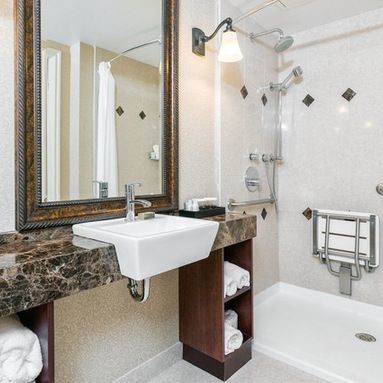Disability is a complex phenomenon representing an interaction between one's physical impairments, the activities one needs to perform, and the architectural barriers within the space in which this situation occurs. Each individual demonstrates the complexity with similar impairments describing his or her limitations differently. The blind don't experience their world the same as a person with deafness. Some of our societal statistics that weigh into Aging in Place situations include reports stating that 19% of the population between the ages of 16 and 64 and 42% of those of us 65 and over have a physical disability affecting the activities of their daily lives.
The situation holds true for adults, and for children with special needs. The building world must work in unison to be sure the entire living environment meets basic needs in addition to affordability and structural integrity for the consumer and homeowner. This includes the home and the components within the home being accessible to all inhabitants needing it most once architectural barriers become a recognized problem for any particular family member regardless of age or ability. Privacy, a sense of belonging, a sense of control, and the sense of safety and security make up the quality of life for any home and should be considered for any barrier-free design.

Traditional homes are commonly full of barriers restricting maneuverability for anyone with a disability. This situation is accentuated once any mobility device is required. Houses typically exhibit home entrances involving steps, narrow doorways, tight hallways with abrupt turns, cramped bathrooms inhibiting comfortable fixture use, inaccessible outside amenities, congested and unfriendly kitchens, and door locking hardware requiring hand strength and coordination.
The concept of the accessible home has evolved beyond the basic grab bars and ramps to one in which accessibility is built into the basic design. Everyone ages differently and has different needs and wants. These factors have brought about the need for Universal Design. This is the design of products, services, and environments usable by as many people as possible regardless of age, ability, or situation without needing adaptation or specialized alterations. It provides the most significant safety and access for home guests or occupants and is undetectable when done well. The principles of Universal Design enable living in a home with more comfort and adaptability for people of all ages and abilities.
Fortunately for people needing increased accessibility beyond what their existing home offers, there is home accessibility help available in Austin, Texas, offered by T-Square Company. T-Square Company specializes in handicap accessible homes and barrier-free remodels having over 30 years of accessibility experience. They provide customized disability home modifications for any age resident with special needs. T-Square Company offers a complete assortment of disability services to help cushion and adapt to any disability including barrier-free home design/build projects. Wider entries and hallways, accessible bathrooms and showers, accessible kitchens, ramped entrances, vertical platform lifts, stair lifts, elevators, and accessible rooms of any type are just a few of the services offered. Every design is based on the specific needs and abilities of the client.
David L. Traut, CAPS the owner and president of T-Square Company in Austin, Texas is one of the select group of professionals nationwide to earn the Certified Aging in Place Specialist (CAPS) designation, identifying him as a home remodeler and builder with the skills and knowledge necessary to remodel or modify a home to meet the unique needs of the older population, disabled owners, or their visitors. Additionally, he is certified in Universal Design in the United States and Australia. David has recently published a book called "Age in Place at Home: Adapting the Home Environment For All Generations". The book explains the importance of Universal Design in building taking you through every room of the home in order to increase home accessibility. It is available on Amazon.

Never fear. You can adapt almost any existing home environment to overcome difficulties and enable you and everyone else in the family to comfortably live at home and move around safely with correct planning and know-how.
Your quality of life will improve if you follow the book's advice. The positive result is every family member has equal accessibility throughout your home's interior. IT JUST MAKES GOOD SENSE.










